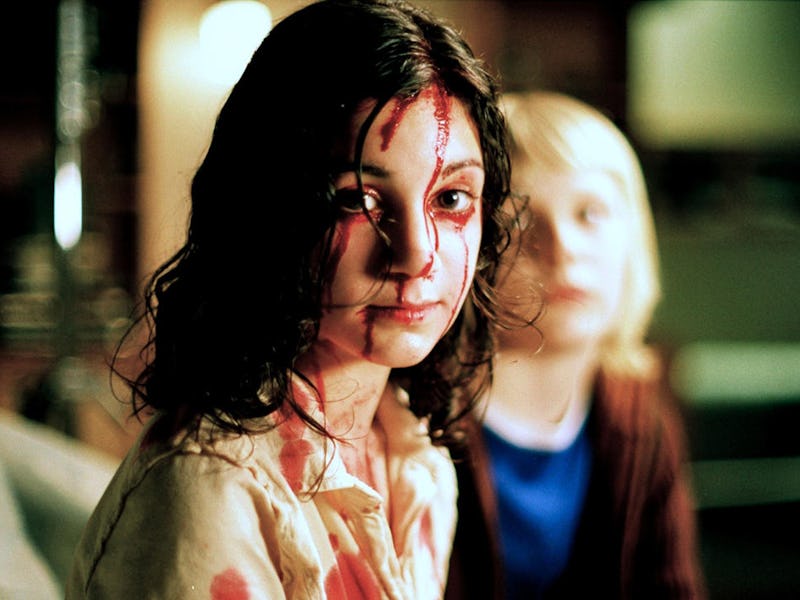It Took a Chilly Swedish Horror Movie to Finally Make Vampires Scary Again
The things we do for love.

In 2008, vampires were facing an existential crisis. More than 100 years after Dracula first emerged from the pages of Bram Stoker’s 1897 classic, the once-intimidating monsters had long lost their fangs thanks to swooning YA books and their glossy big-screen adaptations that romanticized the once-fearsome creatures. Now, vampires were brooding bad boys, not sinister creatures of the night. However, a month before Catherine Hardwicke’s Twilight hit theaters, a nondescript Swedish horror movie introduced one of the most terrifyingly eerie cinematic takes on the vampire.
Based on the 2004 novel of the same title by John Ajvide Lindqvist, Let the Right One In is a chilly, brutal coming-of-age story that happens to feature a vampire. But one of the ingenious decisions by director Tomas Alfredson and Lindqvist, who wrote the screenplay, was to withhold the fact that this was a vampire movie until about two-thirds of the way in. Up until that point, Let the Right One In is a story of Oskar (Kåre Hedebrant), a meek 12-year-old boy who lives with his mother in the western Stockholm suburb of Blackeberg in 1982.
Ostracized and regularly bullied by his classmates, Oskar harbors dark fantasies of murder and revenge, cutting out newspaper clippings of murders and play-acting his fantasies in the frozen courtyard by his apartment. It’s on one of these nights that Oskar meets Eli (Lina Leandersson), a pale young girl who just moved into his apartment complex with an older man who appears to be her father. They strike up a sweet and innocent friendship, and Oskar immediately becomes enamored with Eli. But Eli and her caretaker’s arrival coincides with a series of violent murders that shock the sleepy town.
Let the Right One In is a slow and deliberate mood piece that embeds you in the frozen town of Blackeberg — and its equally frozen people. Shot by cinematographer Hoyte van Hoytema (who would go on to become Christopher Nolan’s go-to director of photography on films like Interstellar, Dunkirk, Tenet, and Oppenheimer), Let the Right One In feels almost clinical in its use of placid dolly shots and harsh natural lighting. It gives the same clinical eye to the gory murder scenes as it does to Oskar’s violent beatings at the hands of his bullies, as well as to the tender moments between Oskar and Eli. The film’s vast, empty space and wintry surroundings are a pretty effective, if on-the-nose, metaphor for the isolation and loneliness experienced by Oskar and other outsiders like him. It’s only when Oskar starts to let Eli in that the film warms up, though the splashes of blood that offer the new warm, red tones in the movie make the viewer uneasy as to whether this is all going to end happily.
Let the Right One In has a surprisingly sweet romance at its core, if it weren’t for all the murder.
Let the Right One In’s enduring impact is that it doesn’t lose its momentum once the vampire reveal is made. It’s still a story of two outcast children finding comfort with each other in a world that's cold and unforgiving. But the comfort they have to offer each other is etched in blood — Eli must murder to survive, and Oskar eventually finds he has the capacity to do the same, for love. The central romance between Oskar and Eli is actually rather sweet and wholesome, only tainted by the outside world that would label them as monsters. It’s a stunted coming-of-age romance, one where one of the children is forever locked in adolescence and deprived of all the morality that would come to them with adulthood.
And even though the vampire elements of Let the Right One In are rather par for the course — Eli drinks blood, would be set on fire by sunlight, and can only be invited into homes by a human — the film makes the most of these elements with some of the most striking imagery and sadistic murders rendered onscreen. It’s no wonder Hollywood jumped to remake Let the Right One In, if only to recreate the cinematic power that is Eli profusely bleeding from their eyes after stepping inside Oskar’s home.
Let the Right One In would be remade in the U.S. as Let Me In, which attempted to make the story more accessible.
Let the Right One In would be remade in the U.S. as Matt Reeves’ (surprisingly solid) Let Me In two years later, though the latter wouldn’t achieve the horror classic status of the original. But the sleeper success of Let the Right One In, and the accelerated path of its remake, would set the stage for a new appreciation of Swedish films the likes of which hadn’t been seen since Ingmar Bergman was a household name.
Shortly after Let the Right One In became an awards darling, The Girl With the Dragon Tattoo became an international phenomenon, leading to an acclaimed remake by David Fincher. Ruben Östlund soon became a staple of the awards circuit with films like Force Majeure and Triangle of Sadness. Horror movies like Thelma and Border got a foot in the door with American audiences that they might never have before. Swedish films (and their U.S. remakes) have become a cornerstone of the new globalized movie stage, and it’s interesting to think that this new era might have begun with a sweet, eerie little vampire film.